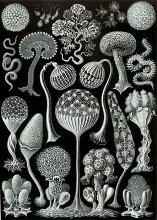Merging worlds – Slime Moulds, the Environment and Human Dignity
March 17 2009:
 |
 |
 |
The 93rd plate from Ernst Haeckel's Kunstformen der Natur (1904), depicting organisms classified as Mycetozoa. Photo from wikipedia. |
By Mary Colwell,
ARC's Catholic Consultant
What drives me to be involved in the dizzy, fast moving and often hugely frustrating
world of Catholicism and the environment is my deep love of the natural world. For
20 years I made wildlife films and radio documentaries for the BBC, and still do on a
part time basis, but increasingly my energies are drawn to encouraging a fruitful
partnership between “environmentalists” and “religious people” , and that is why I
joined ARC (Alliance of Religions and Conservation www.arcworld.org) as their
Catholic consultant.
It’s a strange preoccupation, and some would say futile, but that
is not what I have found and it is certainly not what I witnessed at the Jesuit Pre-
Forum in Belem in January. In Belem there seemed to be little distinction between
the two categories and it was wonderful to witness.
In many ways the Pre-Forum was not unlike watching slime moulds. If you have
never had the pleasure then I highly recommend it as a surprising and enriching way
to spend some hours.
The wonder of slime moulds coalescingSlime moulds are strange slimy blobs that live in forests (very
often) and help the recycling process. These extraordinary wobbly globules of life are
not really plant, not really animal and for much of their lives they exist independently
of each other; a blob here, a blob there, living out their slime-mouldy lives and doing
a great service in their small local area. But then, quite suddenly and for reasons we
don’t really understand, some chemical trigger causes them all to move together (and
sometimes at quite a rate!) and seamlessly coalesce. It is quite a picture, jellies
slithering across a forest floor, drawn together in an almost magnetic way. They can
travel long distances too. What was once a disparate collection of jellies slowly but
surely merge to become one super-jelly. And as so often when we are reduced to the
status of being pure observers of an event we can’t control or really understand, it
brings a sense of humility and delight.
It might seem a long way from a Pre-Forum in Belem, but the image stays with me
because there we witnessed the coalescing of different worlds in a seamless way that
was at once intriguing and heartening to witness. For so long different spheres of
human concern have existed pretty much in isolation from each other; for example
concern for the poor and vulnerable and concern for the environment have been
separate entities that have attracted different people to work with them and rarely
have those worlds met. But this is increasingly not the case, something is moving in
the ether, some trigger is being experienced worldwide that is drawing them
inexorably together to produce a very wonderful and powerful way of looking at
ourselves and the earth.
A coalescing of ideasA super cohesion of ideas, outlook and experience is forming
a more holistic approach to the earth and to humanity; no longer are they separate or
in conflict, they are now linked together, the health and diversity of one being
intricately bound the health and diversity of the other.
In the case of Belem the merging worlds were those of the indigenous experience of
tribes from many places on earth with the concern for the health of the environment.
The intimate knowledge and wisdom of those whose lives are still bound to the
environment they live in is at last being seen as essential to informing a new world
outlook that is so desperately needed. The recognition that the earth is not just a
treasure trove to be plundered for our needs but a gift of immeasurable depth that
imbues us with dignity, wisdom and a connection with God is a product of merging
worlds and it is quite beautiful to observe.
In the West many of us have become increasingly removed from the reality of our
dependence on the natural world. We take for granted the food in our fridges, the
clean water out of a tap, the fresh air we breathe. For many of us these things are on
demand and always present and we left behind many hundreds of years ago the
difficult, struggling reality of obtaining food, drink and shelter from source. But for
99% of human history we had to live in rhythm with the natural world because we
were hunter-gatherers.
 |
 |
 |
Slime mold gathers on a plant in the Olympic National Forest, USA. Photo from wikipedia. |
If we didn’t understand the pattern of animal migrations,
breeding seasons, animal behaviour and sources of clean water, then we died. It is
only recently that most of us have settled in cities and divided labour so that we can
remove ourselves from a partnership with meat and plant material, and along with that
release has come a disregard for natural processes and rhythms which has resulted in
the ecological crisis we see today.
“One of the greatest losses we experienced when
we stopped hunting and gathering and became urbanites was the loss of religious
systems that underpinned our reliance on nature” says Paul Pettitt, Professor of
Archaeology at Sheffield University “and one of the greatest problems has been the
rise of mono-theistic religions that puts humans, or imaginary human like beings, at
the centre of the world. Who cares about a mollusc when there is the Kingdom of
Heaven to look forward to?”
Paul Pettit’s stinging observation goes deep when he is obviously referring to
Christianity as being complicit in the ecological breakdown of the earth’s ecosystems.
Many would agree with him, pointing out the biblical requirement to fill the earth and
subdue it and have dominion over all living things. Not sentiments that win the heart
of dyed in the wool environmentalists.
And so Christianity has a duty to show in a
practical and concrete way that this is not what it seems, that we are charged to tend
and keep the earth and see God in all things. Western Christianity has adopted a
phrase that I am afraid I dislike intensely for its managerial and controlling overtones
– we are called to be “stewards of the earth.” The phrase is not biblical and seems to
have been concocted together from other parables and stories and applied to our
relationship with the earth. But we can never “manage” something so immensely
complicated and out of our control. I am much more drawn to the Orthodox view that
we are all called to be a priesthood of creation, i.e. to bring out the innate holiness of
all living things and empower them to be as God intended.
What defines a Jesuit?This strikes me as being highly Jesuitical in tone. I once made a Radio 4 programme
on Jesuit gardens and I asked Fr Paul Nicholson SJ to explain what it is that defines a
Jesuit and his reply - “Jesuits are men who will do almost anything to help other
people get closer to God”. (www.curlewmedia.com/soundfiles/Jesuits.mp3). It
seems therefore imperative that Jesuits take seriously that aspect of life that really
does connect us in a deep way with the Creator God and brings us to our full
potential. Folding environmental concern and compassion into Jesuit outreach can no
longer be an option.
At the heart of a life of compassion and love that forever reaches out to God is
simplicity. Jesuits and other orders know and give witness to this truth each day
because simple living is at the heart of religious life.
No religious leader ever
preached that the way to holiness is through over consumption and excess; it seems to
be a universal truth that is accepted by all faiths. Therefore it is no surprise to see the
theme of this Lent series is austerity. It is interesting that Pope Benedict used the
same word in his speech on World Tourism day in 2008, calling us to adopt a “joyful
austerity”. Built into a holy life seems to be a measure of discomfort, “suffering” if
you will, that leads to joy and peace. This does not mean austerity in an excessive or
self-indulgent way, but enough to remind us that all we have is gift and nothing a
right, and that God reveals himself in weakness. All people of faith know this to be
true – but how to make it a popular idea in a world that is modelled on constant
economic growth, and consumerism? “Joyful austerity” is not a sound bite that is
likely to be adopted by world politicians anytime soon.
We have to consume less, own less, travel less, procreate less... and want lessPoliticians may talk the talk
of a greener future where we all live more simply and consume fewer resources, but
they can’t really want to see that become a reality. The God of constant growth reigns
supreme in the international world of politics and power. So how can the earth
sustain and humans thrive if the solution to our ills lies in self-sacrifice? Who is
going to promote this? Who is the visionary leader willing to take a different path?
It is true to say that what this earth needs is nothing less than a revolution in the way
we live. We have to consume less, own less, travel less, procreate less and want less.
None of those will be easy to achieve, and I believe they can only be attained through
some kind of revolution of thought or paradigm shift. Revolutions are difficult to
instigate, but history shows us they are possible given the right incentive. In The True Believer: Thoughts on the Nature of Mass Movements Eric Hoffer
studied what it was that inspired people to mass movements and revolutions and his
conclusions must surely strike a chord. He wrote: "those who would transform a
nation or the world cannot do so by breeding and captaining discontent or by
demonstrating reasonableness and desirability of the intended changes or by coercing
people into a new way of life. They must know how to kindle and fan an extravagant
hope" (p 18)
An extravagant hopeSpiritual leaders must know how to “kindle and fan an extravagant hope”. They
must know how to inspire people to make sacrifices and face the future with courage;
revolutionary leaders must know how to bring out the inner hero in us all and allow us
to flourish in a way we never knew possible. That is what the Ignatian family is
charged to do – “Go set the world on fire!” My hopes and prayers are that Jesuits and
associates grasp this opportunity to lead people to a joyful austerity so that all may
become closer to God. I hope they can change the world by helping merge the worlds
of care for the poor, the dispossessed, the weak and the afflicted with care for a
stricken world. And we can only do that through self-sacrifice and compassion for
all.
Shortly after my visit to Belem I found myself in New York and went for a run
through Central Park. Here I saw a wonderful quote from Shakespeare “One touch of
nature and the whole world is kin” from Troilus and Cressida. This is a profound
vision that shows that nature is a great unifier and binder, it strips away class, money,
power and colour and renders us all humble acceptors of the bounties of creation. Let
us work towards strengthening the bond with all life and re-imagining what it is to be
a human being on the earth; and like the slime moulds, seamlessly break down the
flimsy membranes that divide different spheres of concern and work together towards
peace and justice for all living things.
Links
Link to
Wikipedia for more details on slime mold.
|

